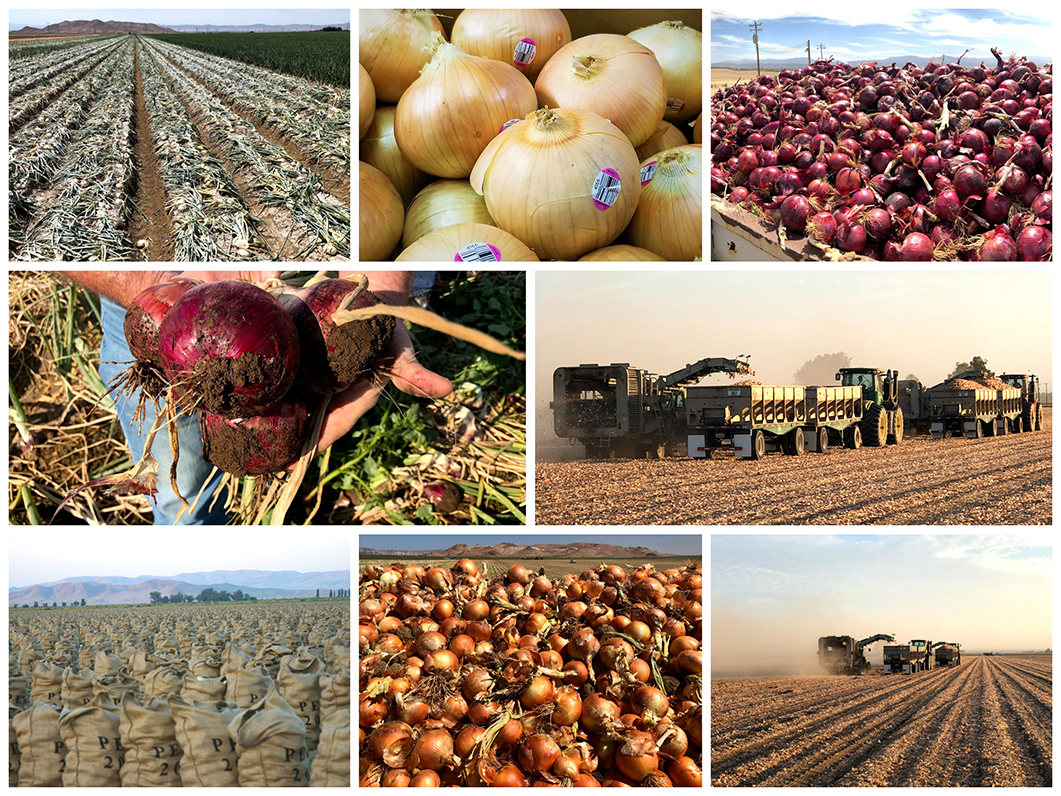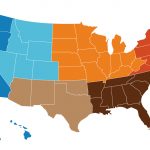 Our Q3 overview starts in mid-July when shippers were citing somewhat “steady” prices, high freight rates and tight labor. That narrative didn’t change a lot over the next few months.
Our Q3 overview starts in mid-July when shippers were citing somewhat “steady” prices, high freight rates and tight labor. That narrative didn’t change a lot over the next few months.
The second week of July had summer onions shipping from Georgia, California, New Mexico and Washington. The story didn’t vary much: Demand was good, and there was a slight uptick in pricing, but it hadn’t reached the point “where it’s been in past years,” according to one Vidalia shipper.
Vidalia had good supplies; other regions were tight on reds and whites. Some reports had the Southwest tight on yellows because of rain. California had good demand and movement, and quality was described as excellent. Walla Walla was halfway through its harvest, and onions were trending jumbo to colossal.
Crop-wise, Washington storage crop was looking good and expected to start in early August. Some Idaho-Eastern Oregon shippers said they’d start shipping the last week of August; others noted they’d be coming in later during August and some in early September. And Northern Colorado saw some of its grower/shippers coming back from fierce winds and hail that hit earlier in the season.
Later in July, more onions were shipping out of Washington’s Tri-Cities area, with one shipper noting “a lot of mediums.” New crop was expected out of the Columbia Basin by the end of July/beginning of August. One shipper in California’s Imperial Valley was working on acreage for 2019 and said there would be increased pricing on contracts for all sizes and colors for 2019 because the difference in pricing for the Pacific NW onions the Imperial Valley had too large. The shipper said higher minimum wage and production costs were causing the increase.
In crop news during that period, Kansas was on track to start harvest in late August, and one Northern Colorado shipper looked to start the first week of August. Western Colorado was coming along with an expected early September start date, and Utah was seeing exceptional quality and size for its fall crop. Idaho-Eastern Oregon growers were citing a good-looking crop with big onions and excellent quality.
In late July some Imperial Valley California shippers told us demand had slacked off somewhat, especially on smaller size yellows. Others reported good demand, with reds and whites seeing the best call. Columbia Basin started shipping some early direct seeded that last week, starting with reds and then moving into whites and yellows. Heat was a potential issue at that time.
A few more IEO shippers were getting into the season, as were some Washington sheds. New Mexico reported high demand for jumbos and larger in all colors. The market was said to be gaining in strength.
Crop news in late July showed a gap between Bakersfield and the higher elevations in California, with harvest in the upper area to start during the first week of August and go into October.
Colorado’s Front Range continued to experience weather events, with some fields taking a hit and others coming through just fine – as is always the case. In Wisconsin, red transplants were set to start shipping within a month, and quality was looking very good.
Early August reports out of California told us long days were being harvested and would ship through mid-September from the Central Valley. One Eastern shipper told us his California and Washington operations were meeting with level demand for yellows, but reds had backed off as customers waited to see if prices would go lower. Transportation was still high, to no one’s surprise. The Walla Walla deal was at its peak, and we heard the market was firm and the quality excellent. Supplies were expected to last through most of August. The Washington hybrid program kicked off, with indications for a normal crop. One Othello shipper told us he was seeing large sizing and good yields – but there was some heat as well.
Some New Mexico guys were finishing up their program for the year, with early to mid-August the clean-up period. Late varieties were running smaller than earlier in the season. Demand was termed “fair,” and the market was steady. Vidalia was still shipping and was expected to have product through August.
Early August crop reports came out of the NW, with the Willamette Valley harvest underway and production ready to kick off. Great quality and ample supplies were cited. IEO had some guys in, and others were preparing to start the second week of August with “excellent quality and great sizing” in all colors. Kansas was within days of starting with “a great mix of sizes.”
New York had seen a small bit of hand harvesting on transplants, but later August and early September would bring full activity. And Peruvian onions were “on the water” and expected to start shipping in mid-August.
The second and third weeks of August had decent quality and steady demand reported for California onions shipped by Eastern operations. Reds were strongest; yellows were steady. Washington was off to a good start, with crews harvesting at night and early in the morning to counter the high heat experienced in the region. Demand was steady; shippers were encouraged. And transportation was good because flatbeds were in big use. Also, exports were picking up. IEO was hitting the ground running, and sheds were saying pretty much in unison, “It’s been busy.” Quality reports were of excellent product in all sizes and colors.
Crops in Colorado were said to be coming along well, and crews were planting in Mexico. New York was also progressing well, looking at a mid-September start.
Mid-August saw California harvesting more long days, and although temps had been high and air smoky due to multiple fires in that state, onions were coming through in good shape. Idaho-Eastern Oregon was shipping full steam, and demand was good for just about everyone. The market was steady.
Crops were progressing in Western Colorado and Utah.
Late August reports told us demand had slowed some for a few days but had picked up as the crops transitioned into Kansas, new fields in Washington and Idaho-Eastern Oregon. Demand was good for big onions. Oregon was shipping its 2018 onions, packing reds, yellows and sweets for good demand. Transportation in the NW was good.
Demand out of California had slowed down as the Northwest geared up, and the market was called steady with good supplies on medium yellows and small jumbo yellows. Bigger onions were tighter. In IEO, demand was good and the market steady. Quality and availability were good on bigger sizes as well, but trucks were starting to get tighter as more shippers came on.
Crops in Northern Colorado were hit by hail earlier in August, and the report late in the month was that it was “wait and see” for some shippers. Western Colorado continued to track to an early September start; Wisconsin was ready to bring in onions in late August and packing by Sept. 10.
Late August and early September saw some Central Valley sheds clean up and Nevada start its 2018 crop season with good demand for whites and sweets. Walla Walla was wrapping up its 2018 season of “tremendous yields” and preparing fields for planting the 2019 onions. Washington was moving a lot of onions, with steady demand and “decent” demand on reds and yellows, better on tight whites. Idaho-Eastern Oregon was heavy to jumbos and tight on mediums with good quality. One IEO shipper told us demand was tremendous as well. Transportation was getting tighter, and labor continued to be very tight in many regions. Western Colorado was clipping and ready to ship.
Washington hybrids were moving steadily, with fresh going well and storage coming on. Many shippers were looking forward to the fall holidays and increased demand, and one cited a $6.50 market on jumbo yellows, saying it’s “not bad.” The pull was from both retail and foodservice, and there was increased demand for exports from the NW.
As the month progressed, some Idaho-Eastern Oregon shippe4rs were seeing increased demand for mediums, which were correspondingly tighter. Others said demand was equal across the board.
Northern Colorado came in with a report that everything was going well with the season – just super busy.
Mid-September saw the Wisconsin crop about 25 percent harvested and supplies expected to run through May. One operation’s California Cuyama Valley crop was nearly harvested, and another was looking to start his onions in late September and finish in late November. Bakersfield and King City were finishing their harvest seasons as well. In Idaho-Eastern Oregon, most shippers were reporting a smooth season today, with good demand and good sales on jumbo yellows as well as other sizes and colors. Pricing was very good on reds and whites that period. Transportation? You guessed it: “Tough.” Labor? “Critical.”
Colorado Western Slope was running whites and yellows mid-month, and Utah was harvesting.
Late September brought harvest of storage onions in New York, and demand was good on jumbo yellows as well as all sizes of reds and whites. The market was described once again as steady. Kansas shippers were seeing good demand for smaller onions. One of our main contacts in North Carolina let us know about hurricane season and damage from Hurricane Florence, saying the hardest hit areas in NC were to the south and east of Raleigh. Hurricane Michael was still in the wings…
Demand in Idaho and Washington was largely called consistent, although one IEO shipper noted during the last week of the month that the market on medium yellows was very strong, and reds and whites were also doing quite well. Washington hybrids continued to move well, along with the Mayan Sweets; demand and pricing were said to be a bit off for Columbia Basin shippers who were nearing the end of harvest. We were told that once onions were in the barn, the market would likely pick up. In addition, exports were offering some relief to the domestic market.
Crop updates during the month told us that Mexico was about halfway through planting its 2019 onions and on track for a mid-January start, and Walla Walla fall planting was completed. Texas Rio Grande Valley was getting ready for an Oct. 5 start to the 1015 crop planting, and crews in Mexico were back in the field planting again after recent rains.
Moving on to early October, New York’s harvest was continuing, and some Canadian onions were also being sold. Wisconsin was experiencing “exceptional demand” the first week, and pricing was also good with medium yellows leading the pack. Northern Colorado had seen a bit of a slowdown in movement during late September, as is typical, and harvest was wrapped up. Colorado Western Slope was about half in, and movement was good with the market “about the same as it was last week.”
Idaho-Eastern Oregon was finishing harvest, much to the delight of all who had the bulk of harvest in the rearview mirror. Weather was just about perfect, we were told, although some late rain did occur. Sizing and quality were reported as good by virtually everyone. Western Oregon finished its harvest, and movement was reported good, especially on reds.
Planting got underway in the Rio Grande Valley of Texas and continued in the Tampico area of Mexico.
Going into mid-October, we found out that harvest was wrapped up for some Washington shippers, and told us jumbos demand had been so good on some days that it exceeded supply. The market had shown some real signs of improvement, and exports remained a very viable outlet. Transportation was still a bear, though. Another Washington shipper cited good demand for medium yellows but cheap pricing on jumbos and larger. Still, another Washington guy told us all colors and sizes were moving, but mediums were the hottest ticket for both domestic and export markets. In Idaho-Eastern Oregon Mother Nature threw a bit of a curveball into harvest and slowed it down at the end for some shippers. Mediums and jumbos were doing the best, one shipper said.
Kansas got off to a slow start because of weather, but the finish was good. North Carolina’s new crop was up, and because of early planting, some operations are looking to start harvest in mid-July. The newly planted onions escaped damage from heavy storms that nailed other crops.
PMA week’s edition of Oct. 18 had reports from shippers who were exhibiting, shippers who were on the floor and shippers who stayed home. One Texas onion man who was home said he was buying out of the Northwest, and he commented that trucks were getting harder to come by. An IEO shipper exhibiting at PMA said back home in the Treasure Valley all sizes and colors were moving well, and pricing was “reasonable.” Another said demand had been consistent, and shipments were ahead of 2017.
Colorado’s Western Slope had been hit by a freeze, and immediate assessments weren’t available. One shipper told us his grower lost some onions, and in the next few weeks, the verdict came back that damage wasn’t what was initially feared.
The Texas Rio Grande Valley’s planting was slowed due to weather, but the crews were still working within the planting window. Mexico was getting a few more seeded in the ground and then wrapped up planting.
Late October had shippers back at home, and we were hearing that the market was a bit sluggish, but PMA had been a great show. Washington was packing some whites and reds in the Walla Walla area, with Mayan Sweets coming in as expected. One multi-state shipper said demand was off for Idaho and Washington, and he speculated PMA, attendance and travel might have played a part. Smaller onions were moving better than larger, and the onion industry continued as a whole to be optimistic that the market would turn around.
More IEO shippers reported they’d finished harvest, and the storage onions looked great. Demand was steady, one shipper told us. Trucks were an issue, and rail was problematic. Utah had everything in the barn, and loads were starting up the third week of October. Trucks were not as hard to come by in that area. New York also finished its harvest during the third week of October, and we heard demand and the market were steady. Mediums were tight.
The Rio Grande Valley remained on a rain delay for planting, but industry insiders were confident everything was still within the window.
The first week of November saw Washington’s sweet program running at a consistent pace, with good quality and business. The market was steady for both sweets and hybrids, and optimism was rising for a good holiday season.
In the Treasure Valley, IEO shippers were bullish on size, quality and volume. Pricing, not so much. But, again, optimism was for an improving market with the coming fall/winter holidays.
Nevada harvest was finished, and though the yellow market was termed “soft,” anticipation was for pricing to firm up. Running all three colors. We’ve loaded a few, and we look for business to build.”
We got a report from Northern Colorado that the freeze that hit Colorado didn’t affect onions in Brighton because they had been replanted earlier in the season and were still in the ground.
Peruvian onions were gaining momentum in early November, with consistent pricing.
Planting in the Imperial Valley and California’s Central Valley began in early November, with good weather helping things along. Crews in the Rio Grande Valley got back into the fields as well and were expected to finish planting by the end of the month’s first week.
The second week of November was a busy one, with harvest wrapping up in King City, CA, and business and transportation good for Columbia Basin operations. In Idaho-Eastern Oregon demand was said to be a little slower, but the expectation was for a good Thanksgiving push the following week. Yellows were moving very well, and the market, again, was termed “steady.” Transportation was becoming more difficult because cold weather precluded flatbed transport. Rail was tight.
Western Colorado and Utah were seeing “awesome” movement, and one shipper told us he was “even short on jumbos.” Wisconsin had good movement and above-average pricing, and New York reported “ridiculously wet” conditions.
And mid-November, which led us to the present, had varied reports. One Northwest shipper said he hadn’t seen a big Thanksgiving push, and mediums continued to sell at a good price – but that was offset by the low prices paid for jumbos.
An Idaho-Eastern Oregon shipper said he’d seen brisk demand, and customers seeded to be stocking up. Quality was good, and pricing was less than optimum. Another IEO shipper said cold, dry weather allowed farmers to get fall field work finished, and he called demand good with a solid Thanksgiving trade. The price was “still cheap.”
Western Colorado and Utah were seeing “phenomenal demand” for their onions, and though trucks were tightening up, the feel was that the market was getting better.
Crop updates that week said the Imperial Valley was finished planting, and shippers expect a “manageable crop” with fewer planted acres.
The Texas Rio Grande Valley was also finishing the last of its planting and replanting, with one shipper telling us a normal start time and normal crop are anticipated. Mexico is in the ground, with some shippers expecting loads in mid- to late January and others around the first of February.
That’s it for the Q3 review. Now… back to turkey and football, y’all. Happy Thanksgiving!



